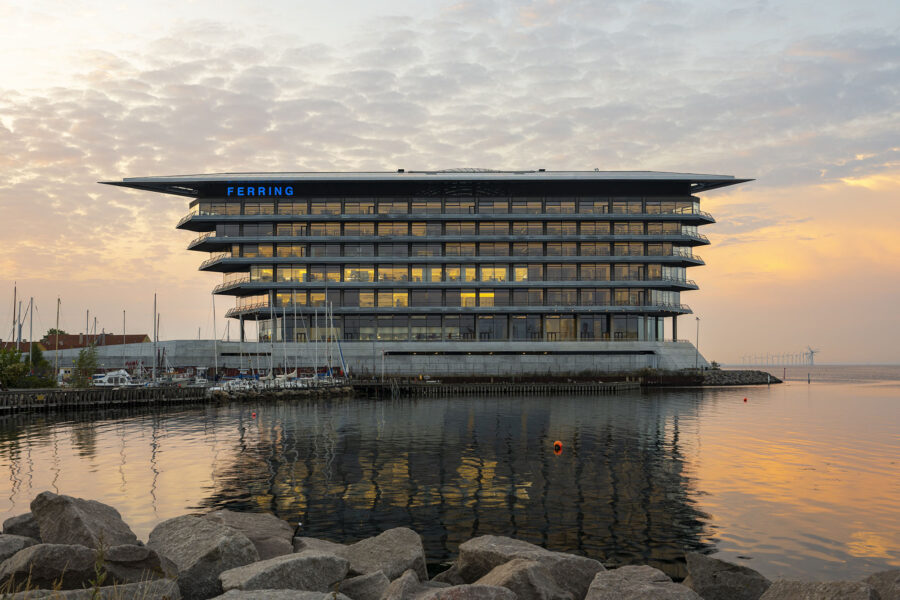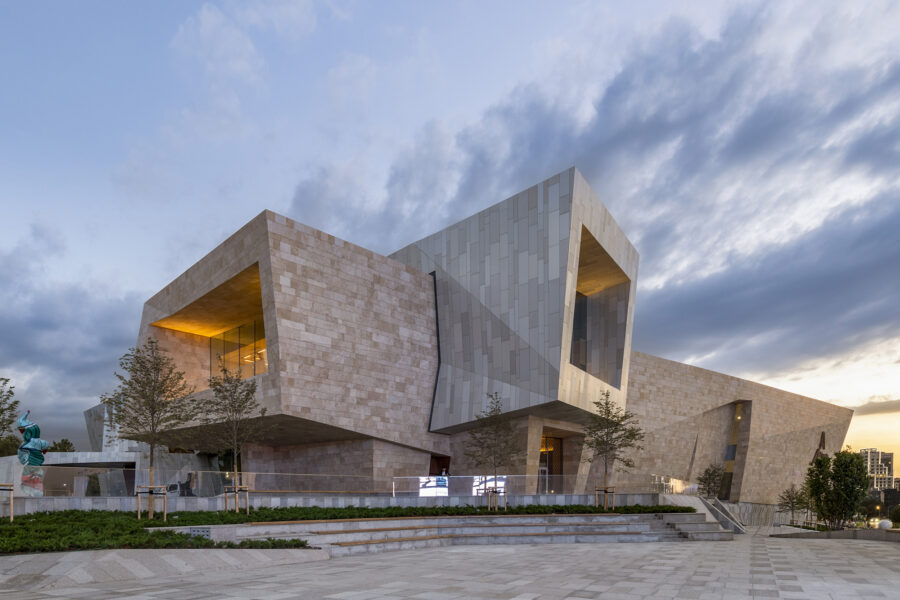
CULTURE


© Ananya Singhal

© Edmund Sumner
インドのラジャスタン州に建つ〈サード・スペース(Third Space)〉は、家庭や学校を超えた境界のない第3の場所として計画された、非営利団体のための学習・文化センターです。
イベントやパフォーマンス、ワークショップ、図書室、カフェなどのさまざまな用途を包括しています。インドの伝統的な中庭住宅から着想した回廊や、地元の白大理石にいくつもの穴を開けた「ジャリ」に包まれたファサード、その穴を開ける際に出た端材を活用した床タイルなど、伝統的な建築技術などを現代的に活用した建築となっています。
イギリスとインドを拠点とする建築事務所 Studio Saarが設計しました。
(以下、Studio Saarから提供されたプレスキットのテキストの抄訳)

© Edmund Sumner

© Edmund Sumner
Studio Saarは、ラジャスタン州ウダイプールに、学校やボランティアと共に地域の課外活動を行う非営利団体Dharoharのための新しい学習・文化センター〈サード・スペース〉を完成させた。
創造性、好奇心、コミュニティの場である〈サード・スペース〉は、あらゆる年齢層を対象とした学習・発見センターであり、教育プログラム、カジュアルな学習の場、社交、舞台芸術のための世界クラスの施設を提供している。

© Ankit Jain

© Ankit Jain
あらゆる学びを提供する第3の場所
「サード・スペース」という言葉が示す通り、家庭や学校を超えた境界のない第3の場所として意図されており、地域の子供たちやあらゆる年齢の人々が、世界とその中での自分の居場所についてより深く理解するために、多様な体験型の活動に出会い、探求することを後押ししている。
この新しいセンターは、1日に最大2,000人の訪問者を受け入れ、幅広い活動やワークショップを提供し、ウダイプールの人々に必要とされる資源を提供する。

© Ankit Jain
〈サード・スペース〉は、Dharoharの重要な原則である「開放性」「アクセシビリティ」「包括性」を育むように設計されており、自由で制限のない空間が、訪問者やスタッフの好奇心、創造性、コミュニティ意識に火をつける。
新しいセンターには、パフォーマンスやコミュニティの集まりに利用できるフレキシブルなエントランススペース、映画館、パフォーミング・アーツ・シアター、科学技術に関するインタラクティブな展示、メーカースペース、ワークショップ&コワーキングスペース、図書室、カフェ&ショップスペース、そして周囲の景色を見渡せる展望台がある。

© Edmund Sumner

© Edmund Sumner
森林再生プロジェクトの一環としての活動
〈サード・スペース〉の活動、プログラム、カリキュラムは、80ヘクタールの丘陵地帯を再び野生化させることを目指す、DharoharとStudio Saarによる森林再生プロジェクトの一環である。
この野心的なプロジェクトでは、地域本来の動植物をこの地に戻し、生物多様性を高めるとともに、両プロジェクトを統合することで、地域社会とそれを支える地元の生態系を結びつけ、さらなる学習の機会を提供する。

© Edmund Sumner

© Ananya Singhal
伝統的な建築遺産から着想しつつ再構築する建築
建物のデザインは、ハヴェリ(編集部註:インドの伝統的なタウンハウス)の中庭住居からインスピレーションを得ており、一連の回廊と日陰の外部循環スペースに囲まれた中央の中庭を特徴としている。
また、ファサードには複雑な模様のジャリ・スクリーン(編集部註:インド・イスラム建築で一般的な穴あき石の装飾)があり、内部と外部を繋ぎながら通風を確保している。

© Edmund Sumner
ゴクラと呼ばれるファサードから小さく飛び出したニッチは、風受けの役割を果たし、建物のパッシブ・クーリングにおいて重要な役割を果たすとともに、読書やミーティング、くつろぎのための遊び心のあるアルコーブとしても機能する。
湾曲したスチールデッキは中庭を取り囲むように配置され、アクティビティやクライミングウォール、パフォーマンスエリアなどを見学できる展望台となっている。中庭には自生する樹木や植栽がさまざまな高さに配置され、道案内の役割を果たすとともに、センターの中心に自然を取り込んでいる。

© Edmund Sumner
地元の白大理石を使用したゴクラを囲むスクリーンを作成する際に発生した切り出しは、床タイルとして使用することで、ファサードと床の間に正負の関係をつくり出す。また、一方、金属製のスクリーンから切り取られた部分は、鎖帷子(くさりかたびら)のようなドアとして形成されている。
近隣の鉱山から出た廃大理石とモルタルが石積みの壁を形成し、大理石の粉がコンクリートのセメントと砂の一部を代替し、太陽の熱をより効果的に反射する白い仕上がりを生み出している。

© Ananya Singhal
冒険的なプレイスケープとして機能する屋上は、パルクールやスケートボードのためのスペースを提供し、Webb Yates Engineersとのコラボレーションで設計された、竹で編まれた日除けのためのキャノピーを備えている。
この竹のキャノピーの継続的なメンテナンスには、地元の織物職人が雇用される。

© Ananya Singhal

© Ananya Singhal
Studio Saarのマネージング・パートナーであるアナンヤ・シンガル(Ananya Singhal)は、次のように語る。
「〈サード・スペース〉にまつわる仕事は、非常にエキサイティングでやりがいのあるものであった。デザイン・プロセスを通じてDharoharと緊密に協力することで、訪問客にもスタッフにも魅力的な空間を開発した。」
「ラジャスタン州の建築遺産からインスピレーションを受け、それらを自由に再構築し、複数の用途を1つのまとまった建物に取り込むことで、今後何年にもわたりコミュニティに楽しさをもたらすことができるのは、とても喜ばしいことである。」

© Ankit Jain
Dharoharの責任者であるシバニ・シンガル(Shivani Singhal)は次のように語る。
「適切な環境と励ましがあれば、人は無限の可能性を引き出すことができる。これが〈サード・スペース〉のビジョンであり、人々が集い、新しいアイデアを探求し、互いに励まし合い、消費者から創造者へとシフトする場所なのである。」
「Studio Saarは、このビジョンの実現と、イノベーションとつながりを促進する空間づくりをサポートしてくれた。私たちは、人々がこのスペースに集い、生涯学習者となることで、私たちがまだ想像できないような方法で、都市や国家が改善されることを願っている。」

© Ananya Singhal

© Ankit Jain

© Ananya Singhal

© Ananya Singhal

© Ananya Singhal

© Ananya Singhal

Ground Floor Plan

Basement Plan

First Floor Mezzanine Plan

Second Floor Plan

Third Floor Plan

Fourth Floor Plan

Fifth Floor Plan

North Elevation

West Elevation

Section A-A

Section B-B
以下、Studio Saarのリリース(英文)です。
Studio Saar completes new discovery centre for local community in Udaipur, Rajasthan
Anglo-Indian architecture practice Studio Saar has completed a new learning and cultural centre in Udaipur, Rajasthan for Dharohar, a not-for-profit organisation working with schools and volunteers to provide extra-curricular activities in the area. Third Space: The Haveli of Creativity, Curiosity and Community is a learning and discovery centre for all ages, that offers world-class facilities for educational programmes, informal learning, socialising and performing arts.
Intended as a ‘third space’ – a place without boundaries beyond home or school, local children and people of all ages are encouraged to encounter and explore diverse, hands-on activities to better understand more about the world and their place within it. The new centre can host up to 2,000 visitors a day, offering a broad range of activities and workshops, providing much-needed resources to the people of Udaipur.
Third Space is designed to foster Dharohar’s key principles of openness, accessibility, and inclusivity, resulting in a free, unrestricted space which ignites curiosity, creativity and a sense of community for visitors, volunteers and staff. The new centre features a flexible entrance space for performances and community gatherings, a cinema, performing arts theatre, an interactive exhibition of science and technology, tinkering and maker spaces, workshopping and co-working spaces, a library, a café and retail space, and a lookout tower to take in surrounding views.
Third Space’s activities, programmes and curriculum are connected to 80 hectares of hills that are being rewilded as part of a reforestation project by Dharohar and Studio Saar. The ambitious project will see local flora and fauna returned to the area to increase biodiversity and the integration of both projects will provide further opportunities for learning, connecting the community with the local ecosystem that sustains it.
The building’s design draws inspiration from traditional havelis courtyard homes, featuring a central courtyard surrounded by a series of cloisters and shaded external circulation space. The facades feature intricate patterned Jali screens that provide ventilation while connecting the inside to the outside. Small, cantilevered niches in the façades, known as gokhra, act as wind catchers, playing a key role in the building’s passive cooling strategy and doubling as playful alcoves for reading, meeting and relaxing. A curved steel deck weaves around the courtyard and serves as a viewing platform allowing visitors to observe the programme of activities, climbing wall and performance area below. The structure is populated by native trees and planting at multiple levels, aiding with wayfinding, and bringing nature into the heart of the centre.
Cut-outs from the building’s local white marble screenwork and gokhra are used as floor tiles, creating a positive-negative relationship between facades and floors, while cut-outs from the metal screens form chainmail screens and doors. Waste marble rubble and lome mortar from nearby mines form the masonry walls and marble dust replaces some of the cement and sand content in the concrete mix – resulting in a whiter finish that more effectively reflects the sun’s heat.
The roof acts as an adventurous playscape, offering spaces for parkour and skateboarding, and features a woven bamboo canopy to provide solar shading, designed in collaboration with Webb Yates Engineers. Bamboo was chosen for the canopy and local weavers will be employed in its ongoing maintenance, resulting in a low-cost, low-carbon solution that creates steady local employment and reinforces the preservation of a traditional craft.
Ananya Singhal, Managing Partner of Studio Saar said: “Working on Third Space has been an incredibly exciting and rewarding journey. Throughout the design process, we’ve worked closely with Dharohar to develop a space that will appeal to visitors and staff alike. It was a joy to draw inspiration from the architectural heritage of Rajasthan and have the freedom to reimagine it, bringing multiple uses into a single coherent building that will bring joy to the community for years to come.”
Shivani Singhal, Head of Dharohar added: “Given the right environment and encouragement, people can unlock their limitless potential. This is the vision of Third Space – a place where people come together, explore new ideas, encourage each other, and shift from being consumers to creators. Studio Saar was able to help us realise this vision and create a space that encourages innovation and connection. We hope as people come together in this space to become life-long learners, they will improve tour city and nation in ways that we cannot yet imagine.”
Third Space is now open to the public – to find out more about its programme and activities, visit the Third Space website www.third-space.in.
Models, photographs, drawings, visualisations and a film of Third Space will be featured alongside Studio Saar’s other significant projects in the practice’s upcoming exhibition Craft, Community and Connection as part of the 2024 London Festival of Architecture (LFA). The exhibition celebrates Studio Saar’s vision of creating uplifting spaces and places for all and is taking place at the Crafts Council Gallery in Angel, London from 07 June until 15 June. To find out more, visit the LFA website: https://www.londonfestivalofarchitecture.org/event/craft-community-connection-celebrating-public-and-communal-spaces-with-studio-saar.
About Studio Saar
Studio Saar was established by Jonny Buckland and Ananya Singhal in 2019 having collaborated for over a decade. The studio’s architecture is underpinned by the ambition to create sustainable solutions for society, achieved by cross-cultural sharing of emerging ideas, methodologies and technologies.The practice is split across its two offices in Frome, Somerset and Udaipur, Rajasthan. Its architecture is rooted in understanding the importance of people, culture and place. Whether in Somerset or Rajasthan, the studio’s approach interprets vernacular traditions through a contemporary lens to deliver innovative, relevant, and beautiful design solutions across a range of typologies.
Key schemes include Secure Sanand Factory and Canteen in Ahmendabad, Gujurat; the redevelopment of Udaan Park in Udaipur; the Mayday masterplan for Saxonvale Frome; as well as residences in the UK and India.
Studio Saar is a subsidiary business of Secure Meters, an Indian multi-national smart metering and energy management business with operations in India, UK, Bangladesh, Australia, Italy, Singapore, Switzerland, Sweden, and the UAE.
About Dharohar
Dharohar is a philanthropic institution that is funded and managed by the Singhal Family. The Singhal Family own Secure Meters, an Indian multi-national smart metering and energy management business with operations in India, UK, Bangladesh, Australia, Italy, Singapore, Switzerland, Sweden, and the UAE.Dharohar believes that everyone is born curious and wanting to learn. Its work fosters that spirit and re-ignites it in adults who find themselves in a rut. Every year, the not-for-profit organisation works with 30 to 40 schools (around 4,000 students a year), with some programmes supporting student’s academic learning and others providing extra-curricular enrichment. Each programme is designed to have a set number of sessions, as well as the opportunity for schools to visit its centre in a shopping mall at their leisure.
Dharohar follows a constructivist and experiential philosophy, helping students build on what they know and develop their own understanding. Its programmes are designed to make participants independent learners, so there is a strong focus on metacognition, and the process rather than a specific knowledge outcome. Underlying its programmes is a layer of socio-emotional learning, helping students navigate the challenges of not understanding, or finding something hard. It tries to include collaborative components where students can help each other learn and support each others’ learning.
Studio Saar 公式サイト
https://www.studiosaar.design






![[大阪・関西万博]海外パビリオン紹介_ベルギー](https://magazine-asset.tecture.jp/wpcms/wp-content/uploads/2025/06/07002852/IMG_1592-900x595.jpg)


